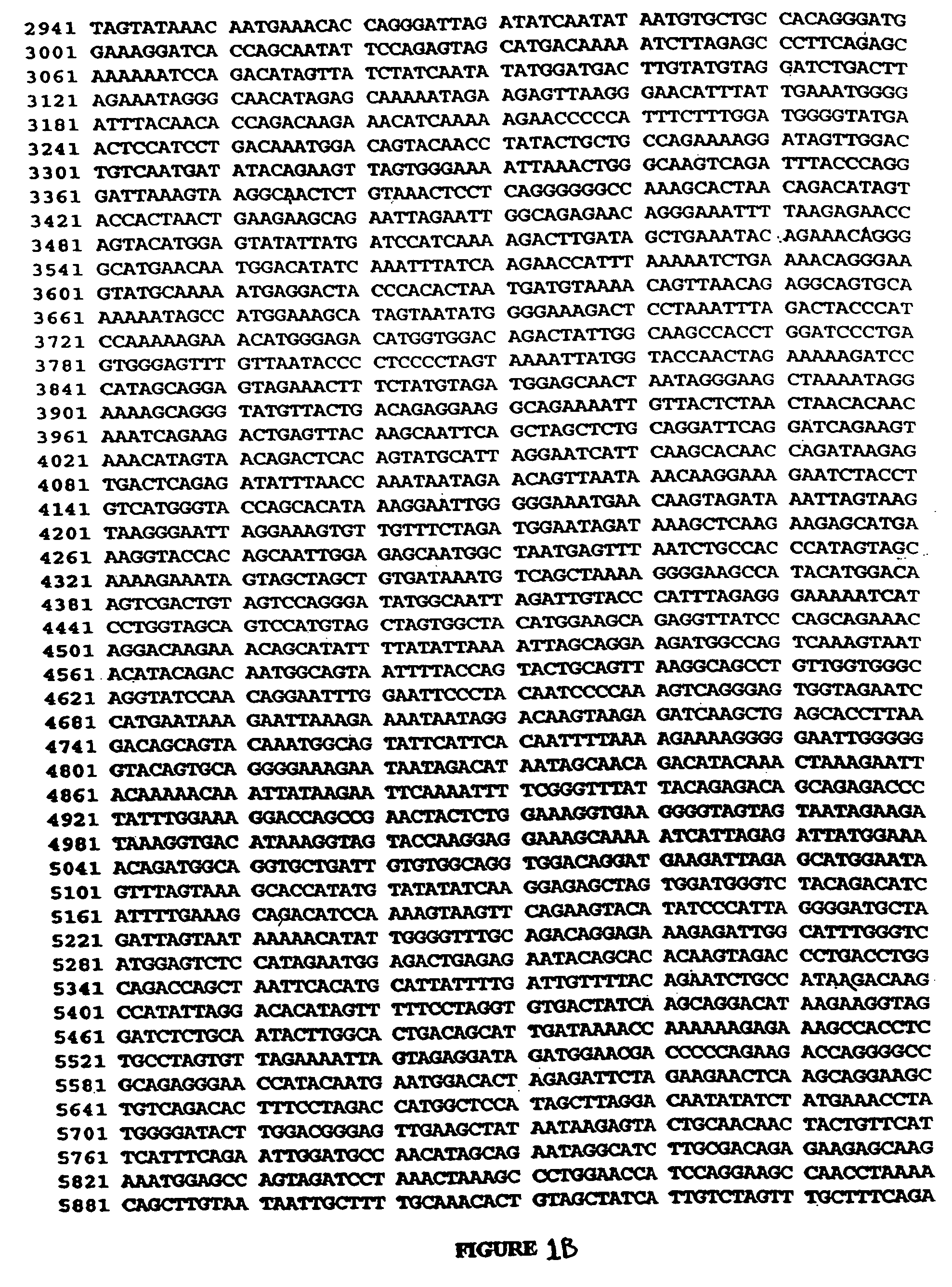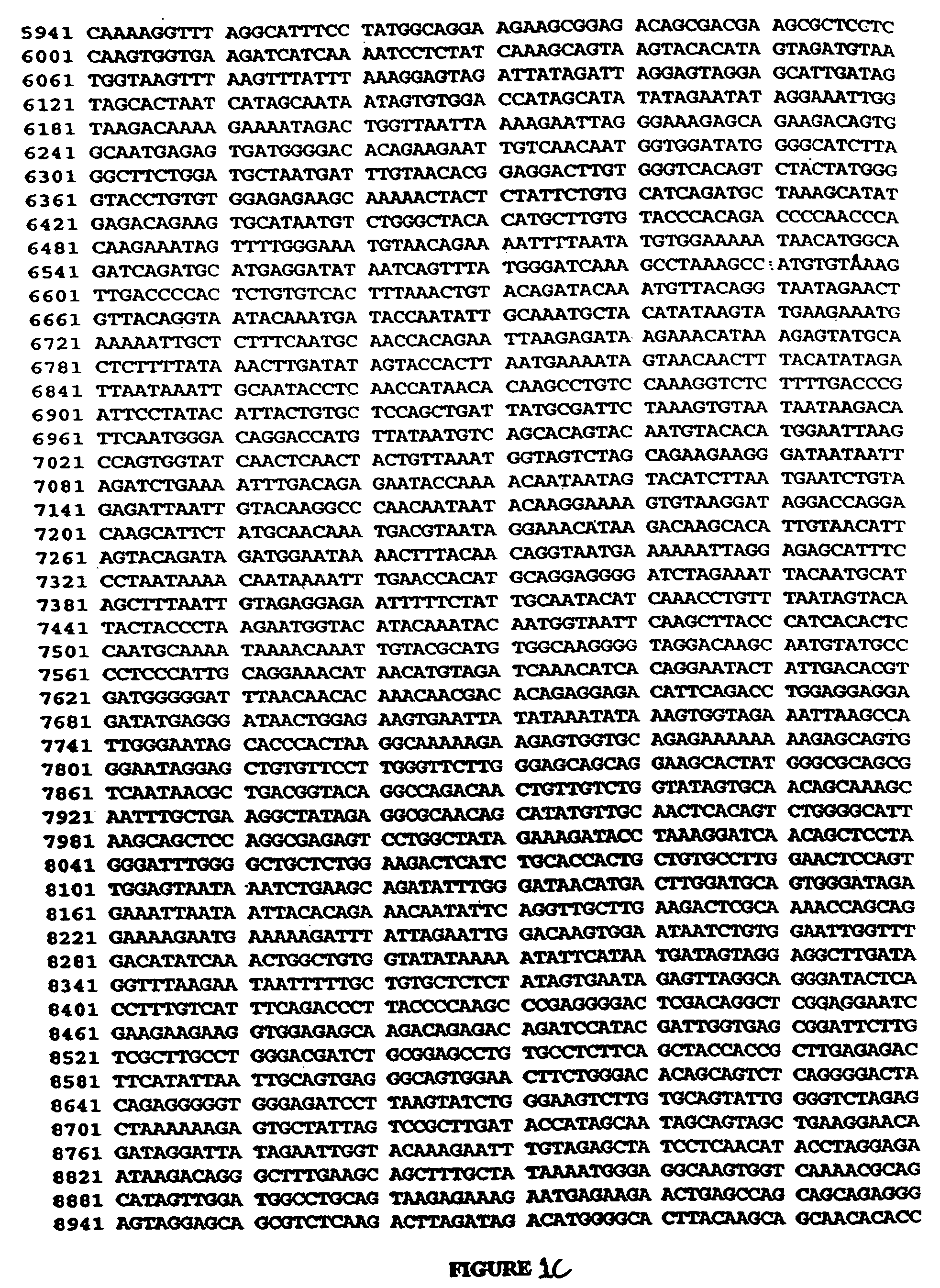Polynucleotides encoding antigenic HIV type B polypeptides, polypeptides and uses thereof
- Summary
- Abstract
- Description
- Claims
- Application Information
AI Technical Summary
Benefits of technology
Problems solved by technology
Method used
Image
Examples
example 1
Generation of Synthetic Expression Cassettes
A. Generating Synthetic Polynucleotides
[0325] The polynucleotide sequences of the present invention were manipulated to maximize expression of their gene products. The order of the following steps may vary.
[0326] First, the HIV-1 codon usage pattern was modified so that the resulting nucleic acid coding sequence was comparable to codon usage found in highly expressed human genes. The HIV codon usage reflects a high content of the nucleotides A or T of the codon-triplet. The effect of the HIV-1 codon usage is a high AT content in the DNA sequence that results in a high AU content in the RNA and in a decreased translation ability and instability of the mRNA. In comparison, highly expressed human codons prefer the nucleotides G or C. The wild-type sequences were modified to be comparable to codon usage found in highly expressed human genes.
[0327] Second, for some genes non-functional variants were created. In the following table (Table B...
example 2
Expression Assays for the Synthetic Coding Sequences
[0340] The wild-type sequences are cloned into expression vectors having the same features as the vectors into which the synthetic HIV-derived sequences were cloned.
[0341] Expression efficiencies for various vectors carrying the wild-type (any known isolated) and corresponding synthetic sequence(s) are evaluated as follows. Cells from several mammalian cell lines (293, RD, COS-7, and CHO; all obtained from the American Type Culture Collection, 10801 University Boulevard, Manassas, Va. 20110-2209) are transfected with 2 μg of DNA in transfection reagent LT1 (PanVera Corporation, 545 Science Dr., Madison, Wis.). The cells are incubated for 5 hours in reduced serum medium (Opti-MEM, Gibco-BRL, Gaithersburg, Md.). The medium is then replaced with normal medium as follows: 293 cells, IMDM, 10% fetal calf serum, 2% glutamine (BioWhittaker, Walkersville, Md.); RD and COS-7 cells, D-MEM, 10% fetal calf serum, 2% glutamine (Opti-MEM, Gibc...
example 3
Western Blot Analysis of Expression
[0345] Western blot analysis of cells transfected with the HIV expression cassettes described herein are performed essentially as described in co-owned WO 00 / 39302. Briefly, human 293 cells are transfected as described in Example 2 with pCMV6a-based vectors containing native or synthetic HIV expression cassettes. Cells are cultivated for 60 hours post-transfection. Supernatants are prepared as described. Cell lysates are prepared as follows. The cells are washed once with phosphate-buffered saline, lysed with detergent [1% NP40 (Sigma Chemical Co., St. Louis, Mo.) in 0.1 M Tris-HCl, pH 7.5], and the lysate transferred into fresh tubes. SDS-polyacrylamide gels (pre-cast 8-16%; Novex, San Diego, Calif.) are loaded with 20 μl of supernatant or 12.5 μl of cell lysate. A protein standard is also loaded (5 μl, broad size range standard; BioRad Laboratories, Hercules, Calif.). Electrophoresis is carried out and the proteins are transferred using a BioRad...
PUM
| Property | Measurement | Unit |
|---|---|---|
| Fraction | aaaaa | aaaaa |
| Fraction | aaaaa | aaaaa |
| Fraction | aaaaa | aaaaa |
Abstract
Description
Claims
Application Information
 Login to View More
Login to View More - R&D
- Intellectual Property
- Life Sciences
- Materials
- Tech Scout
- Unparalleled Data Quality
- Higher Quality Content
- 60% Fewer Hallucinations
Browse by: Latest US Patents, China's latest patents, Technical Efficacy Thesaurus, Application Domain, Technology Topic, Popular Technical Reports.
© 2025 PatSnap. All rights reserved.Legal|Privacy policy|Modern Slavery Act Transparency Statement|Sitemap|About US| Contact US: help@patsnap.com



